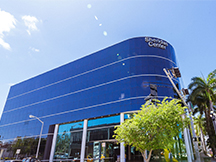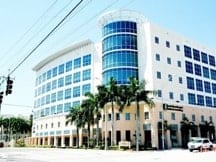Achilles Tendon Surgery
Book Your Free Consultation
What is achilles tendon surgery?
The Achilles tendon is a large thick tendon located behind your ankle, and is the strongest tendon of your body. The Achilles tendon is formed from two muscles in the leg called the Gastrocnemius and the Soleus muscles and insert on the back portion of the heel bone. The function of the Achilles Tendon is to control the downward motion of the foot (also referred to as plantarflexion), or simply put, allows you to stand or walk on your “tippy toes”. A properly functioning Achilles tendon is crucial for walking, running, jumping and daily activity.
Causes: Generally, Achilles Tendon Ruptures are a result of a sudden or acute injury. It is very common for people to experience Achilles ruptures when they’ve lived non-active lives and suddenly engage in activities that are more intense than they’re used to, and even athletes too. Achilles tendon ruptures frequently occur when the Achilles tendon is overstretched with a sudden jump, pivot, sprint, or after a slip and fall. Achilles Tendon Rupture and tendons tend to weaken over time. Systematic medical conditions such as inflammatory arthritis and diabetes, in addition to certain blood types, may hinder tendon integrity.
Sign & Symptoms: It is common for patients to experience swelling, bruising, and intense pain as a result of a rupturing their Achilles tendon, with the potential of not being able to walk or stand on the affected leg. For the first several days, the injury is usually painful to touch., but exaggerated swelling may make this difficult to feel.
Diagnosis and Treatment: Achilles ruptures are diagnosed with patient history and several tests performed by a medical professional. During the exam, it is possible for surgeons to feel the rupture. A clinical test to evaluate for a rupture is with the Thompson test, which involves squeezing of the calf which to see if the foot moves. Another test involves having the patient lay on their stomach and bend both knees – if the feet are situated at different levels, there is a possible rupture. Unlike x-rays, ultrasounds may identify a rupture. Magnetic resonance imaging is the most accurate method for the viewing the Achilles Tendon and can readily identify a rupture, its severity and location, and possible tendon retraction.
The foundation of Achilles repair surgery involves re-attaching the ends of the torn Achilles tendon. The Achilles tendon repair involves weaving strong suture within the Tendon and tying the ruptured ends together. Repairs generally depend on the location of the tendon’s tear.
Mid-substance Achilles Tendon Repair: When the Achilles tendon ruptures centrally, there are tendons on both sides of the rupture. This is the most common area for Achilles tendon ruptures, which occur about 4 centimeters up from the heel bone. In this classic Achilles repair, the tendon ends are sewn together by weaving suture throughout both ends of the tendon. The ends are tied together centrally at the rupture site.
Insertional Achilles Tendon Repair: This procedure is ideal for when the Achilles tendon is ruptured directly at the heel bone. Simply put, the Achilles has been detached completely off the bone. The repair involves a tendon-to-bone re-attachment rather than repair of the tendon itself. A special suture with a bone anchor is used (commonly referred to as tenodesis). Several bone anchors can be used to secure the tendon to the bone, and the suture is also weaved into the Achilles tendon.
Muscular Achilles Tendon Repair: This is the most complex Achilles rupture because the Achilles tendon is torn directly at the junction of the muscle, which occurs higher up behind the ankle. This is more challenging to repair because muscle is more friable than tendon, and doesn’t hold the suture as securely. Nonetheless, the suture is weaved throughout the muscle.
Additional Achilles Repair Modifications: While the location of the rupture is important to determine the correct procedure, the severity of the rupture plays an important role in the repair. Sometimes, the tendon is completely shredded and simple repair is not possible. It is also common for shortening to occur with the rupture, which can be serious if not corrected at the time of surgery.
Achilles Tendon Reconstruction
Flexor Hallucis Longus Tendon Transfer Achilles Repair: This repair involves rebuilding the Achilles tendon by using the tendon (flexor hallucis longus) responsible for curling the big toe down. This tendon also functions on the ankle as an accessory to bring the foot downward, and is optimal for use with certain Achilles repair surgeries. The flexor hallucis longus repair is a commonly utilize technique when rebuilding the Achilles tendon with chronic injuries.
Achilles Turndown Flap: Another technique to manage Achilles repair defects involves using the Achilles tendon itself to bridge the tendon gap. Here the top part of the tendon is specially cut, rotated, and flapped downward to bridge any gaps. This technique requires enough tendon available to flap down and is not a useful technique for ruptures close to the heel bone or at the muscle juncture.
Plantaris Tendon Achilles Repair: This is an additional procedure where a small/tiny tendon, known as the Plantaris tendon, is used to support or augment the Achilles tendon repair. The Plantaris tendon is adjacent to the Achilles tendon, making it easier to access for surgeons, but its miniscule size makes it difficult to frequently utilize.
Acellular Achilles Repair: Tissue grafts may be utilized to augment the Achilles repair. The graft may be used to wrap the Achilles tendon repair after it has been sutured together. The tissue can be derived artificially, from animals or humans. Some surgeons find this technique useful whereas others prefer one’s own body for maximum healing results.
Allografts Achilles Repairs: Structural tendon grafts from another person are uncommonly used for acute Achilles repairs and are only considered for tendon defects. Despite the limited availability of tendon allografts (especially since they’re sourced from someone else), they are not typically needed for acute repairs but rather used for chronic Achilles tendon repairs.
Minimally Invasive Achilles Surgery
In general, most Achilles repairs are performed with an incision located directly along the Achilles Tendon. Minimally invasive surgery allows for a smaller incision located directly over the Achilles Tendon rupture site for mid-substance ruptures. The sutures are placed through pinholes and passed through to the ruptures site where they are tied together for the repair. However, because the technique is performed through limited access, the suture cannot be weaved in an interlocking fashion throughout the Achilles tendon. This does not speed the recovery process, but still results in proper functionality of the area.
Recovery: Usually, it takes the Achilles tendon six to eight weeks to repair itself, with surgery options bringing about longer recovery times. Once the Achilles tendon has mended, physical therapy is recommended to gain full functionality, a complete process that can last about three months.
- Gastrocnemius Release
What is: Gastrocnemius release is performed in corrective foot and ankle surgery, calf-contouring cosmetic surgery, or dermatologic, infectious, or oncologic pathologies that directly effect the gastrocnemius muscle. The gastrocnemius muscle is seldom completely resected to avoid lower extremity gait and stability issues. Generally, partial or subtotal resection of the gastrocnemius muscle is performed to achieve desired cosmetic or musculoskeletal results. Calf-contouring surgery for gastrocnemius hypertrophy has also been achieved through selective neurectomy of the sural nerve.
Causes: This procedure is suggested if a patient feels a sudden pain at the back of the leg, particularly at the muscular tendinous junction. Additionally, other causes include:
- Difficulty in contracting the muscle, or standing on your toes.
- Pain, swelling, or bruising in the calf muscle.
- Pain from resisted plantar flexion or contracting the muscles against resistance.
- If the Soleus muscle is damaged, pain might be incurred lower in the leg and when contracting the muscle against resistance with the knee bent.
Sign & Symptoms: Gastrocnemius contracture results in the inability to bring the ankle joint past a neutral position (right angle to the lower leg) with the knee straight. Instead of walking on their toes, most people naturally and unconsciously compensate by having more motion through the joints in front of the ankle. This midfoot compensation often leads to increased repetitive pressure to various structures in the foot during standing and walking. Therefore, the presence of a contracture may lead to painful conditions of the foot.
Recovery: The average recovery period for a gastrocnemius procedure is approximately six weeks. Patients may be allowed to return to a sedentary job within a few days after surgery. Patients with labor intensive jobs that require prolonged standing, squatting, kneeling, or stair/ladder climbing may not be able to return to work for approximately eight weeks or may
return sooner with restrictions on these types of activities. If you’re surgery occurred on your right leg, you may not drive for up to three weeks.
Dr. Ray Lopez
Minimally Invasive Bunion Surgery

- Main Office:
- Miami Beach 400 Arthur
- Godfrey Road Suite #412
- Miami Beach, FL 33140

- South Miami
- 6200 Sunset Drive Suite #402
- South Miami, FL 33143

- Pembroke Pines
- 601 N. Flamingo Road
- Suite #101, Pembroke Pines, FL 33028

- Aventura
- 21000 NE 28th Ave.
- Suite #203, Aventura, FL 33180





